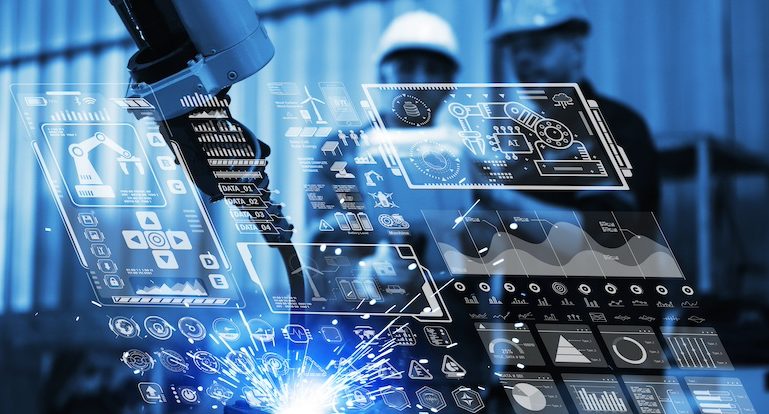
Author:
Mohsen Shamsi
Category:
Articles
Study time: 10 minutes
Intelligent monitoring systems for production lines are technologies that automatically monitor and analyze the performance and status of production equipment and processes. These systems use sensors, Internet of Things (IoT), artificial intelligence (AI) and big data to collect and process information. The main goal of these systems is to increase productivity, reduce downtime, predict problems and improve production quality.
The key features of smart monitoring systems include the following:
These systems allow real-time monitoring of machinery and processes.
Using artificial intelligence algorithms, these systems are able to predict potential problems before they occur and prevent sudden failures.
The information collected from the sensors is processed and analyzed to ensure the optimal performance of the systems.
Smart monitoring systems can optimize energy consumption and prevent waste of resources.
These systems can be integrated with enterprise resource planning (ERP) systems and distribute production data throughout the organization.
This technology helps factories and production lines move towards intelligent manufacturing and more effectively face the challenges of modern manufacturing.

Intelligent monitoring systems for production lines are a set of advanced technologies that help companies and factories to monitor and optimize their production processes and equipment performance in real time. These systems are known as an important part of Industry 4.0 and intelligent production. In the following, we will discuss more details of these systems and their features and benefits
Sensors collect critical information from machinery and processes, including temperature, pressure, vibration, speed, energy consumption, and more. This information is the basis for real-time monitoring and detailed analysis of production processes.
Sensors are connected to monitoring systems through IoT networks. The Internet of Things enables devices and equipment to automatically collect and transmit data. This communication makes the systems aware of the status of machines and production lines in real time.
One of the most important parts of intelligent monitoring systems is artificial intelligence algorithms. These algorithms can identify the behavior patterns of machinery and equipment and predict breakdowns, optimize processes and increase efficiency.
Intelligent systems collect huge amounts of data from production lines. This data is processed using advanced analytical tools to lead to actionable results. Big data analysis allows organizations to identify long-term trends and make better and faster decisions.
Intelligent monitoring systems receive real-time information from machines and show it to operators. This capability allows production teams to immediately identify and fix any disruptions or problems.
Using historical data and artificial intelligence, these systems can predict potential failures. Preventive maintenance through equipment condition analysis prevents sudden breakdowns and reduces maintenance and repair costs.
Using the data obtained, these systems can make suggestions to improve the performance of the production line. These optimizations include reducing energy consumption, increasing production speed, improving product quality, and reducing waste.
Intelligent monitoring systems can easily be integrated with other management systems such as enterprise resource planning (ERP) systems and quality management systems (QMS). This integration improves organizational processes and makes better decisions.
These systems are easily scalable and can be implemented in small production lines to large factories.
With accurate and real-time monitoring of production lines, problems are quickly identified and fixed, which reduces downtime and increases productivity.
Smart systems reduce overall production costs by reducing unexpected breakdowns, optimizing energy consumption, and reducing waste.
Accurate and analytical data helps to improve the quality of products and can reduce production defects through process optimization.
Accurate and real-time information helps managers make better decisions and plan more accurately.
With the real-time monitoring of the equipment, possible risks and problems are quickly identified, which leads to an increase in the safety of the work environment and a reduction in accidents.
Smart monitoring systems are used in various industries:
Automobile industry: monitoring the quality of parts, managing production schedules and optimizing energy consumption in automobile production lines.
Pharmaceutical industries: strict monitoring of production and packaging processes to ensure quality and compliance with health standards.
Food industry: quality control, raw material tracking and optimization of production and packaging processes.
Steel and mining industries: monitoring the efficiency of heavy machinery and reducing downtime.
As a key tool in the fourth industrial revolution, these systems help factories move towards intelligent production and achieve higher productivity and cost reduction goals.

One of the main advantages of using intelligent monitoring systems is reducing the downtime of machinery. Equipment breakdowns and unexpected shutdowns can be costly for factories. Smart systems monitor the current state of the equipment using advanced sensors and algorithms and quickly detect any abnormalities or problems. These systems are able to:
Predicting failures: through the analysis of past and present data, the system can warn before a serious failure occurs. This allows companies to make preventive repairs before problems occur and avoid production downtime.
Reduction of unnecessary stoppages: By reducing the number of unexpected stoppages and emergency repairs, continuous production continues at a faster pace and overall productivity increases.
Energy consumption is one of the biggest costs of a production line. Smart monitoring systems help to reduce energy consumption by monitoring energy consumption in different equipments. These systems can:
Detection of high consumption areas: parts of the production line that consume energy in an unusual way are identified and the possibility of optimizing their consumption is provided.
Optimization suggestions: By analyzing energy consumption patterns, systems can provide optimization suggestions to significantly reduce energy costs.
Reduced costs and environmental impact: By optimizing energy consumption, overall production costs are reduced and the factory's environmental impact is reduced, which can help meet environmental regulations.
Another important benefit of intelligent monitoring systems is improving product quality and reducing waste in production processes. These systems optimize production processes by collecting and analyzing data related to the quality of materials and parts produced. Intelligent systems can:
Identification of production anomalies: Any defects in the production process or raw materials are quickly identified and necessary corrective measures are taken to ensure the quality of the final product.
Reducing production waste: By optimizing processes and preventing the production of defective parts, the amount of production waste is reduced. This not only reduces production costs, but also reduces environmental impacts.
Ensuring quality stability: through accurate and real-time monitoring, these systems can ensure stability in product quality and improve production quality over time.
One of the outstanding features of intelligent monitoring systems is the possibility of preventive maintenance and predictive maintenance. By continuously monitoring equipment status and collecting data from sensors, these systems can:
Detecting problems before complete failure: By analyzing data collected from machinery, the systems detect early signs of failure and warn operators to take necessary actions before complete failure.
Increasing the useful life of equipment: by performing preventive repairs and preventing serious breakdowns, the useful life of machinery increases and the need for early replacement of parts decreases.
Reduced maintenance costs: With preventive maintenance and repairs, costs related to emergency repairs and sudden breakdowns are significantly reduced.
Smart monitoring systems have a direct impact on increasing safety in the workplace and reducing the risks of breakdowns and possible defects. Through real-time monitoring of the status of equipment and processes, these systems are able to:
Detection of possible risks: Any abnormality in the operation of the equipment that may lead to safety risks is quickly identified and preventive measures are taken.
Reducing the occurrence of work accidents: By monitoring the correct operation of equipment and preventing sudden breakdowns, the occurrence of accidents and injuries related to machinery is reduced.
Improved working conditions: Smart systems can monitor temperature, pressure and other environmental conditions in the factory to ensure optimal conditions for employees.
One of the most important advantages of using intelligent monitoring systems is data-driven decision-making. With accurate and real-time information on production status, managers can make smarter, data-driven decisions. These decisions include:
Optimizing production processes: The data obtained from monitoring systems can help managers identify weak points in production lines and improve them.
More accurate planning: with real-time information on the status of equipment and material inventory, production planning and supply of raw materials can be done more optimally.
Transparency and better communication: These systems allow access to production data in real time and more transparency is created in the processes. Also, information can be easily transferred to other departments such as sales and logistics to create more coordination in the organization.
Smart monitoring systems have high scalability. These systems can be easily implemented in small or large production lines and increase their scale over time with the growth and development of the company or factory. Also, with changes in production processes, intelligent systems can be easily adjusted and adapted to new needs
Intelligent monitoring systems can easily be integrated with other management and information systems in the organization, such as enterprise resource planning (ERP) systems and quality management systems (QMS). This integration helps improve efficiency and reduce inconsistencies throughout the organization.
Using advanced technologies such as the Internet of Things, artificial intelligence and big data, intelligent monitoring systems help factories and production lines to optimize their processes, increase product quality and reduce costs. These systems not only increase productivity, but also improve safety and transparency, helping organizations to perform better in a competitive environment.


By entering your email in this section, you will find out about the latest articles published on the site
education
Articles
New
Tehranpars first square, Maleki St., 46, Unit 4
info@dinaeam.com
برای استفاده از دمو نرم افزارهای دینا فرم زیر را تکمیل فرمایید.
